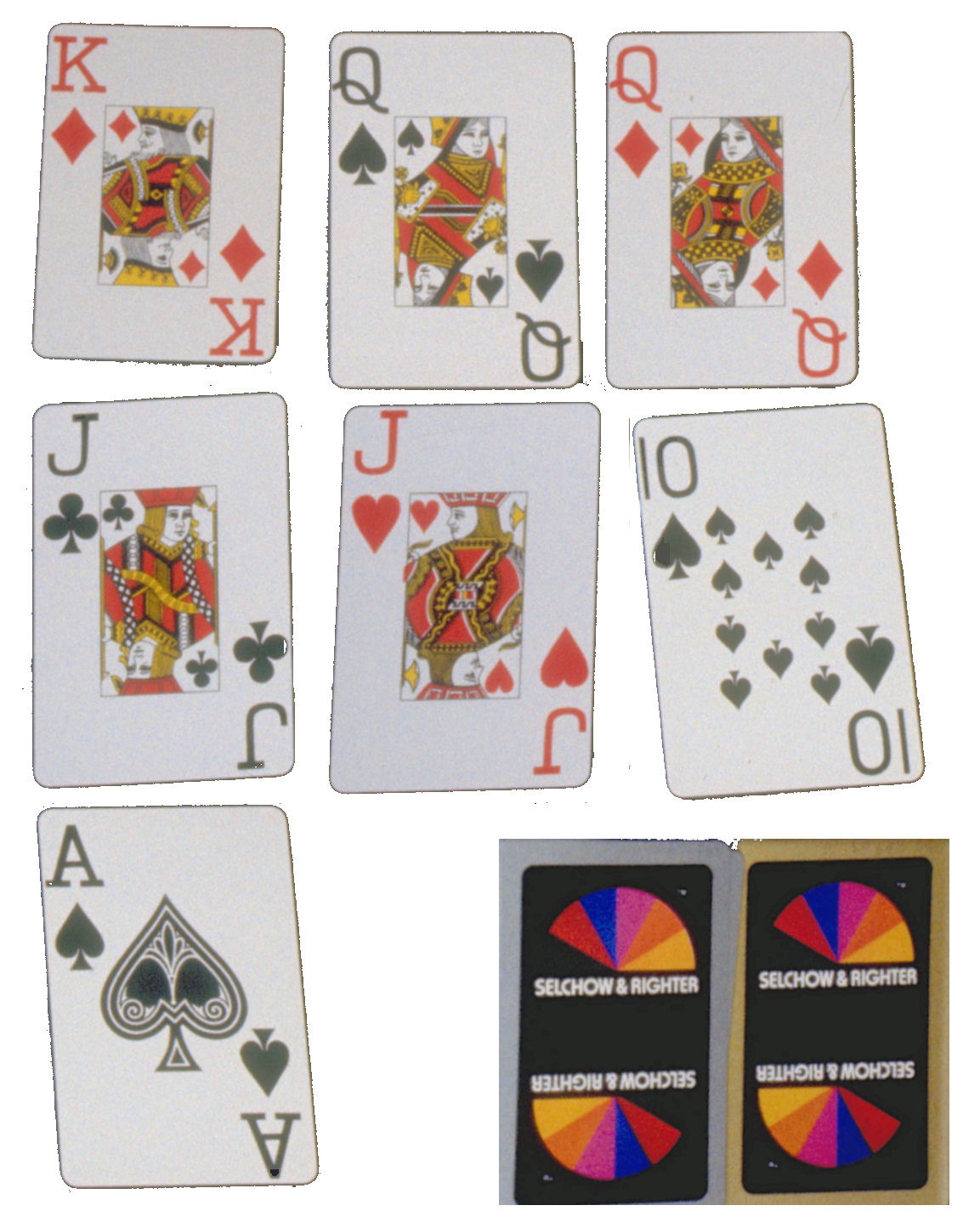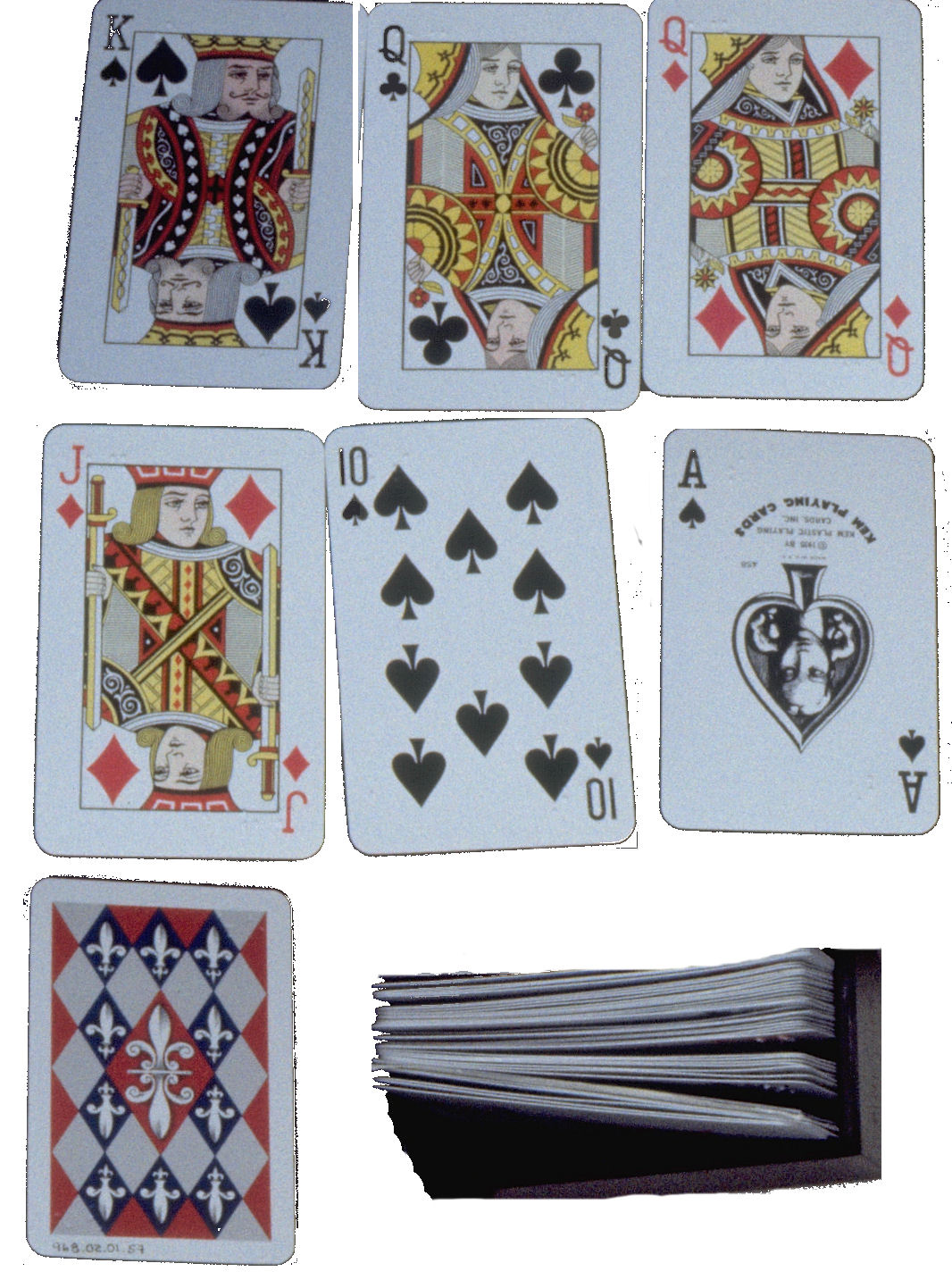People who have visual limitations are not prevented from playing card games. There are two types of decks available to these people: Sight-Saver cards for people with limited vision, and Braille marked cards for people who are blind and can read Braille.

This partially pictured deck was acquired in 1971. It was manufactured by the US Playing Card Company, Cincinnati, Ohio (US) in the 1960s.
The deck comes in a lidded box 9.5cm long x 7cm wide x 1.5cm thick. The lid has embossed information about the deck on the top (upper right of picture). Card backs are illustrated in the lower right of the photograph.
The deck is composed of 52 cards (8.8cm long x 6.8cm wide) and 2 jokers. One joker is pictured below the box. It is a "standard" deck of playing cards which uses the international suit symbols. However, all of the usual card faces (including the numbered cards) are reduced in size, while the corner indicators are increased in size.
The notion is that people with limited vision may more easily identify each card because of the enlarged corner suit indicators.

The partially pictured deck at the right is a similar "Sight-Saver" deck. This deck was manufactured by Selchow & Righter Company, New York, and was donated to the collection in 1982. S&R did not sell these decks, but gave them away in their New York showroom as gifts.
There are two 52 card decks in the double box (9.5cm long x 12.2cm wide x 2cm thick.). Each deck includes 2 jokers. The box is pictured at the right of the photograph. The lid features the S&R logo. A thumbnail cut is in the center of both sides of the lid to enable opening the box. The cards (8.6cm long x 5.5cm wide) are a "standard" deck of playing cards, using the international suit symbols. One deck is framed in black and the other in gold.
As in the deck pictured above, all of the usual card faces (including the numbered cards) are reduced in size, while the corner indicators are increased in size to enable easier identification of the cards by people with visual impairment.
Braille is a system of writing and printing for visually impaired or sightless people, in which varied arrangements of raised dots representing letters and numerals are identified by touch. It was invented for visually impaired or sightless people in 1829 by Louis Braille (brāl). Braille (1809-1852) was a French musician, and educator. He lost his sight at the age of three. (Excerpted from The American Heritage® Dictionary of the English Language, Third Edition © 1996 by Houghton Mifflin Company.)

The deck partially pictured at the left is a specially manufactured deck of cards. Each card is made of plastic and features Braille markings below the suit symbols in both the upper left and lower right of each card. Known as "Kem Cards", the deck was manufactured by Kem Plastic Playing Cards Inc., Poughkeepsie, New York (US) in the 1960s. It was acquired in 1971.
The 52 card "standard" deck with 2 jokers comes with a 30 page booklet containing information on the care of the cards, how to clean them (they are washable), and other information about card quality. There are additional cards with manufacturer's information about replacement of one or more cards. The deck and the other information sits upright in a plastic box (9.4cm long x 4.2cm wide x 3.7cm high). The box lid is 9.4cm long x 4.2cm wide x 3.8cm high.
The card backs have an elaborate and colorful design (lower left). Cards are 8.9cm long x 5.7cm wide. Other than the special Braille marking, all cards are a "standard" deck which uses the French national suit symbols.

At first glance, the partially pictured deck on the right might look the same as the previously pictured and described deck - but it is not the same! This is a Pinochle Deck.
Pinochle is a special Bezique-like trick taking game played with a non-standard deck of cards. The deck is made from two decks of cards with all cards from the two to the eight removed. Thus there are 48 cards in the Pinochle deck - two of each Ace, King, Queen, Jack, Ten, Nine. The deck was acquired in 1971.
In all other respects, this deck is like the previous one made by Kem Plastic Playing Cards Inc. The box is similar, but in this instance has the word "Pinochle" printed in gold on one end of the box bottom. The cards are the same size as the previously pictured deck, however the backs have a different colorful design. Braille markings are on the upper left and lower right corner of each card next to the international suit symbol. This deck comes with the same information about card care and replacement.
NOTE: This page was originally created and posted on the Web on March 27, 1995. Subsequently it has been modified and periodically updated. Last update: June 14, 2010